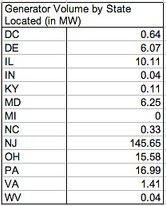2011 Update: State certification information can be found here
One of the benefits of the SRECTrade multi-state auction platform is the ability to cross-list in multiple states in which you have registered your SRECs. If an SREC is cross-listed, it will be included in any state in which it has been registered to be sold. SRECs will be sold in the state auction that offers the most value. In order to qualify to sell your SRECs in a state that accepts out-of-state SRECs, you need to get your system certified in that state. The following section has information on what states accept out-of-state SRECs and how to get your systems registered and obtain a state certification number. For EasyREC customers, SRECTrade can help you register in the states available to you.

SREC State Registration Information:
Delaware
To get a Delaware state certification number, your installation must be located in DE. You must apply to become an Eligible Energy Resource. The link for the application is here. For more information, go to the Delaware Public Service Commission.
Contact:
Delaware Public Service Commission
861 Silver Lake Boulevard
Cannon Building, Suite 100
Dover, DE 19904
Main: (302) 736-7500
Toll-Free: (800) 282-8574
Fax: (302) 739-4849
District of Columbia
Eligible to states within and adjacent to the PJM Region. For information on the DC registration process, see DC State Certification Instructions.
Contact:
Dorothy Wideman
Commission Secretary
Public Service Commission of the District of Columbia
1333 H Street, N.W
2nd Floor West Tower
Washington, D.C. 20005
Maryland
To register in Maryland, your solar installation must be in MD and you must complete and file an application for certification as a Solar Renewable Energy Facility (REF) with the Public Service Commission. The link to the application is here. For more complete details on the process, see Maryland SREC Registration Details.
New Jersey
New Jersey is a closed market, therefore only SRECs produced in New Jersey are eligible. New Jersey residents can apply for state certification at the New Jersey Office of Clean Energy’s website.
Contact:
New Jersey’s Clean Energy Program
c/o Conservation Services Group
75 Lincoln Highway, Suite 100
Iselin, New Jersey 08830
Phone: 866-NJSMART (866-657-6278)
North Carolina
North Carolina is still in the early stages of implementing an SREC program. The state is still accepting applications for a REC tracking system through December 15, 2009. More information can be found on the North Carolina Utilities Commission website. A sample application can be found here.
Contact:
Chief Clerk
North Carolina Utilities Commission
4325 Mail Services Center
Raleigh, NC 27699-4325
Ohio
Utilities in Ohio are allowed to procure 50% of the SRECs from out of state facilities. However, these states must be contiguous with Ohio (PA, MI, IN, KY, WV). Instructions and forms required for Ohio certification can be found here: Application for Certification as an Ohio Renewable Energy Resource Generating Facility
Contact:
Public Utilities Commission of Ohio
Email: AEPS@puc.state.oh.us
Toll-Free: (800) 686-PUCO (7826)
Phone: (614) 466-3292 (in Columbus area)
Fax: (614) 752-8351
180 East Broad Street
Columbus, Ohio 43215
Directions to the PUCO
Pennsylvania
Utilities in Pennsylvania are allowed to buy out of state SRECs from solar generators in the PJM region to meet the Renewable Portfolio Standard. If you are interested in selling in PA, you need to get your solar system registered. For a detailed explanation of the process with screenshots see our most recent post on Pennsylvania State Certification Registration Process.
Contact Info:
Dina M. Deana
Pennsylvania AEPS Program Manager
Clean Power Markets, Inc.
Phone: 1-877-AEPS-773 (1-877-237-7773)
Fax: (610) 444-9213
Email: paaeps@cleanpowermarkets.com





